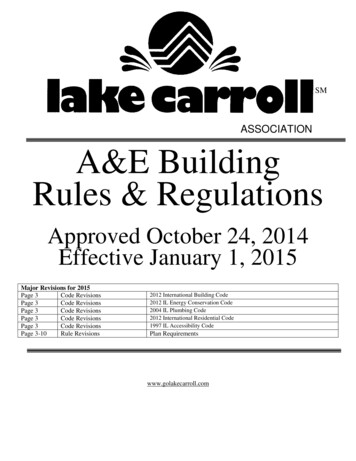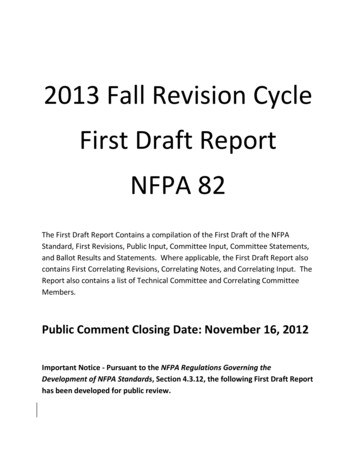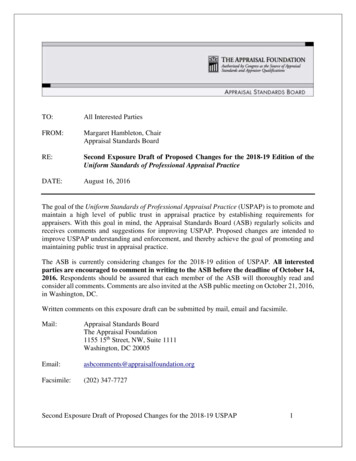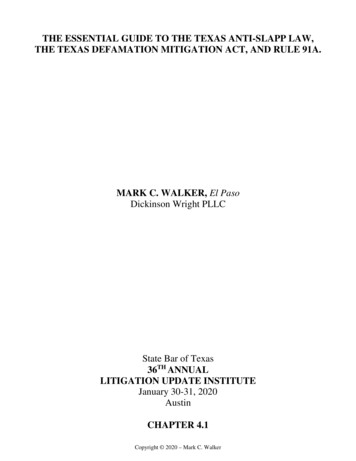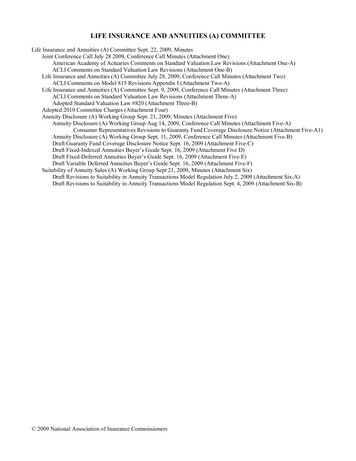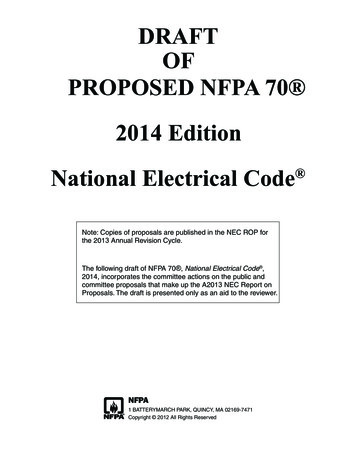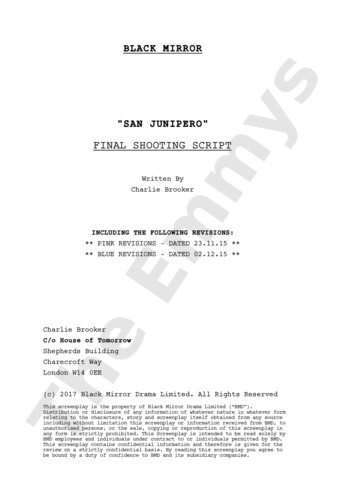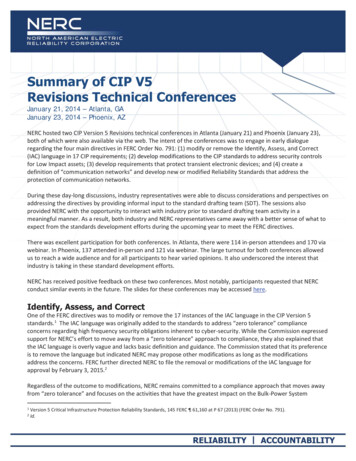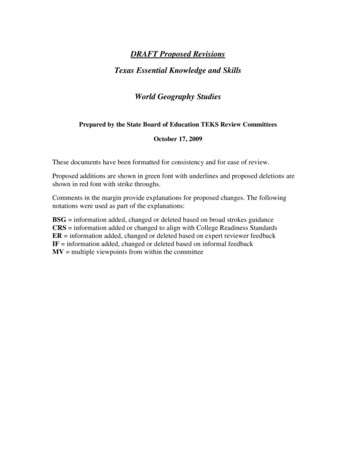
Transcription
DRAFT Proposed RevisionsTexas Essential Knowledge and SkillsWorld Geography StudiesPrepared by the State Board of Education TEKS Review CommitteesOctober 17, 2009These documents have been formatted for consistency and for ease of review.Proposed additions are shown in green font with underlines and proposed deletions areshown in red font with strike throughs.Comments in the margin provide explanations for proposed changes. The followingnotations were used as part of the explanations:BSG information added, changed or deleted based on broad strokes guidanceCRS information added or changed to align with College Readiness StandardsER information added, changed or deleted based on expert reviewer feedbackIF information added, changed or deleted based on informal feedbackMV multiple viewpoints from within the committee
World Geography Studies§113.34. World Geography Studies (One Credit).(a) General requirements. Students shall be awarded one unit of credit for successful completion ofthis course.(b) Introduction.AFT(1) In World Geography Studies, students examine people, places, and environments at local,regional, national, and international scales from the spatial and ecological perspectives ofgeography. Students describe the influence of geography on events of the past and present withemphasis on contemporary issues. A significant portion of the course centers around thephysical processes that shape patterns in the physical environment; the characteristics of majorland forms landforms, climates, and ecosystems and their interrelationships; the political,economic, and social processes that shape cultural patterns of regions; types and patterns ofsettlement; the distribution and movement of world population; relationships among people,places, and environments; and the concept of region. Students analyze how location affectseconomic activities in different economic systems throughout the world. Students identify theprocesses that influence political divisions of the planet and analyze how different points ofview affect the development of public policies. Students compare how components of cultureshape the characteristics of regions and analyze the impact of technology and humanmodifications on the physical environment. Students use problem-solving and decision-makingskills to ask and answer geographic questions.R(2) To support the teaching of the essential knowledge and skills, the use of a variety of richprimary and secondary source material such as contemporary and historic maps of varioustypes, satellite-produced images, photographs, graphs, map sketches, and diagrams isencouraged.Comment [A1]: ER-“Stronger emphasis onpractical news-driven geography”BSG-“Address global events that are occurring rightnow”Comment [A2]: RedundantComment [A3]: Changed from “sketch” to “mapsketch” for clarification and to align with thenational standardsD(3) The eight strands of the essential knowledge and skills for social studies are intended to beintegrated for instructional purposes. Skills listed in the geography and social studies skillsstrands in subsection (c) of this section should be incorporated into the teaching of all essentialknowledge and skills for social studies. A greater depth of understanding of complex contentmaterial can be attained when integrated social studies content from the various disciplines andcritical-thinking skills are taught together.(4) Throughout social studies in Kindergarten-Grade 12, students build a foundation in history;geography; economics; government; citizenship; culture; science, technology, and society; andsocial studies skills. The content, as appropriate for the grade level or course, enables studentsto understand the importance of patriotism, function in a free enterprise society, and appreciatethe basic democratic values of our state and nation as referenced in the Texas Education Code,§28.002(h).October 17, 2009Page 1 of 11
World Geography Studies(5) State and federal laws mandate a variety of celebrations and observances includingCelebrate Freedom Week. Each social studies class shall include, during Celebrate FreedomWeek as provided under Texas Education Code, §29.907, or during another full school week asdetermined by the board of trustees of a school district, appropriate instruction concerning theintent, meaning, and importance of the Declaration of Independence and the United StatesConstitution, including the Bill of Rights, in their historical contexts. The study of theDeclaration of Independence must include the study of the relationship of the ideas expressedin that document to subsequent American history, including the relationship of its ideas to therich diversity of our people as a nation of immigrants, the American Revolution, theformulation of the United States Constitution, and the abolitionist movement, which led to theEmancipation Proclamation and the women's suffrage movement.(c) Knowledge and skills.AFTEach school district shall require that, during Celebrate Freedom Week or other week ofinstruction prescribed under subsection (a) of this section, students in Grades 3-12 study andrecite the following text: "We hold these Truths to be self-evident, that all Men are createdequal, that they are endowed by their Creator with certain unalienable Rights, that among theseare Life, Liberty and the Pursuit of Happiness--That to secure these Rights, Governments areinstituted among Men, deriving their just Powers from the Consent of the Governed."R(1) History. The student understands how geographic contexts the geography of places in thepast and processes of spatial exchange (diffusion) influenced events in the past and helped toshape the present. The student is expected to:D(A) analyze the effects of physical and human geographic patterns and processes onevents in the past and describe their impact on the present effects on present conditions,including significant physical features and environmental conditions that influencedmigration patterns in the past and shaped the distribution of culture groups today; and(B) trace the spatial diffusion of a phenomenon phenomena such as the ColumbianExchange or the diffusion of American popular culture, and describe its the effects onregions of contact. such as the spread of bubonic plague, the Columbian Exchangediffusion and exchange of foods between the New and Old Worlds, or the diffusion ofAmerican popular culture slang.Comment [A4]: BSG-Unnecessary language,repetitive as described in “ensure studentexpectations are concise, clear”Comment [A5]: BSG&CRS- Unnecessarylanguage, repetitive; addresses the CRS concern IIIA(1)– greater emphasis on spatial patternsComment [A6]: BSG-Using correct vocabularyComment [A7]: BSG-Terminology too narrow,does not fully address topicComment [A8]: BSG-Changed order in interestof clarity and accuracyOctober 17, 2009Page 2 of 11
World Geography Studies(2) History. The student understands how people, places, and environments have changed overtime and the effects of these changes on history. The student is expected to:(A) describe the human and physical characteristics of the same place at differentperiods of history regions at different periods of time to evaluate relationships betweenpast events and current conditions; and(B) assess how people's changing perceptions of geographic features have led tochanges in human societies explain how changes in societies have led to diverse uses ofphysical features.AFT(3) Geography. Such as The student understands how physical processes shape patterns in thephysical environment. (lithosphere, atmosphere, hydrosphere, and biosphere), including howEarth-Sun relationships affect physical processes and patterns on Earth's surface. The student isexpected to:(A) attribute occurrences of weather phenomena and climate explain weatherconditions and climate in relation to annual changes in Earth-Sun relationships;(B) describe the environmental characteristics, physical environment of regions andthe physical processes that affect these regions such as the environments of regionsincluding weather, tectonic forces, erosion, wave action, freezing and thawing, gravity,and soil-building processes; andR(C) examine the physical processes that affect the lithosphere, atmosphere, hydrosphereand biosphere.Comment [A9]: Repetitive, unnecessaryComment [A10]: BSG-Change necessary toclarify expectation;CRS-states I A(3) analyze how physical and culturalprocesses have shaped human communities overtime.Comment [A11]: BSG-Change necessary toclarify expectation and “ensure student expectationsare concise, clear”Professional development is recommended toprovide examples of SEComment [A12]: Moved to student expectation(SE)Comment [A13]: BSG-Change necessary toclarify expectationComment [A14]: BSG-Using correct vocabularyComment [A15]: Too specific to include in theknowledge and skills statementD(4) Geography. The student understands the patterns and characteristics of major landforms,climates, and ecosystems of Earth and the interrelated processes that produce them. The studentis expected to:(A) explain the distribution of different types of climate in terms of patterns oftemperature, wind, and precipitation and the factors that influence climate regions suchas elevation, latitude, location near warm and cold ocean currents, position on acontinent, and mountain barriers; (A) explain how elevation, latitude, wind systems,ocean currents, position on a continent, and mountain barriers influence temperature,precipitation, and distribution of climate regions;(B) relate the physical processes to the development of distinctive land forms; and (B)describe different landforms and the physical processes that cause their development;andOctober 17, 2009Comment [A16]: BSG-Change necessary toclarify expectation and “ensure student expectationsare concise, clear”Comment [A17]: BSG-Change necessary toclarify expectation and “ensure student expectationsare concise, clear”Page 3 of 11
World Geography Studies(C) explain the influence of climate on the distribution of biomes plants and animals indifferent regions of the world. using the relationships among, vegetation, soil, andgeology.Comment [A18]: BSG- Change necessary toclarify expectation and “ensure student expectationsare concise, clear”(5) Geography. The student understands how political, economic, and social processes shapecultural patterns and characteristics in various places and regions. The student is expected to:(A) analyze how the character of a place is related to its political, economic, social, andcultural characteristics elements; and(B) interpret analyze political, economic, social, and demographic indicators (GDP percapita, life expectancy, literacy, infant mortality) to determine the level of developmentand standard of living in nations using the terms Human Development Index; lessdeveloped, newly industrialized and more developed.AFT(6) Geography. The student understands the types and patterns of settlement, the factors thataffect where people settle, and processes of settlement development over time. The studentunderstands the types, patterns and processes of settlement . The student is expected to:(A) locate settlements and observe patterns in the size and distribution of cities usingmaps, graphics, and other information; and (A) locate and describe human and physicalfeatures that influence the size and distribution of settlements; andR(B) explain the processes that have caused cities to grow such as location alongtransportation routes, availability of resources that have attracted settlers and economicactivities, and continued access to other cities and resources. (B) explain the processesthat have caused changes in settlement patterns including urbanization, transportation,access to and availability of resources, and economic activities.(7) Geography. The student understands the growth, distribution, movement, andcharacteristics of world population. The student is expected to:D(A) construct and analyze population pyramids and use other data, graphics, and mapsto describe the population characteristics of different societies and to predict futuregrowth population trends;(B) explain how the political, economic, social, and environmental push and pullfactors and physical geography affect the routes and flows of human migration; andfactors that contribute to human migration such as how national and internationalmigrations are shaped by push-and-pull factors and how physical geography affects theroutes, flows, and destinations of migration;Comment [A19]: BSG-“Ensure studentexpectations are concise, clear”Comment [A20]: Rather than two “analyze” in arow, changed to interpret which is same level andmore appropriate to conceptsComment [A21]: BSGSpecifics inserted in consideration of assessment andto improve vertical alignment with Grade 6 andEconomicsComment [A22]: BSG&CRS-Using correctvocabulary; CRS III A (1) “Placing emphasis onspatial patterns of communities within politicalboundaries”ER- Committee decided to maintain terminologywith input from expert reviewer Dr. Kracht – seeExplanations for text-Committee notes that NationalGeographic Standards use the terms “developing”and “developed,” but the decision to use theterminology here was based on input from collegeprofessors.Comment [A23]: BSG- Elements moved to SE;needed to clarify knowledge and skills; “over time”implied in “changes” in SE (B)Comment [A24]: CRS-CRS I A( 6) states“analyze the relationship between geography and thedevelopment of human communities”Removing methodology of “using maps, graphics”Comment [A25]: BSG-“Ensure studentexpectations are concise, clear” and use correctvocabularyComment [A26]: Inaccurate, not all populationsgrowComment [A27]: BSG-“Ensure studentexpectations are concise, clear”(C) describe trends in past world population growth and distribution; and(D) examine benefits and challenges of globalization including connectivity, standardof living, pandemics and loss of local culture.(D) develop and defend hypotheses on likely population patterns for the future.October 17, 2009Comment [A28]: CRS- “Analyze how and whydiverse communities interact and become dependenton each other.” CRS IIIA3- important terminology.This SE will need to be addressed in professionaldevelopment discussions.Page 4 of 11
World Geography Studies(8) Geography. The student understands how people, places, and environments are connectedand interdependent. The student is expected to:(A) explain the interrelationships among physical and human processes that shape thegeographic characteristics of places such as connections among economic development,urbanization, population growth, and environmental change;(B) (A) compare ways that humans depend on, adapt to, and modify the physicalenvironment including the influences of culture and technology; using local, state,national, and international human activities in a variety of cultural and technologicalcontexts;AFT(C) (B) describe the interaction between humans and the physical environment andanalyze the consequences of extreme weather and other natural disasters impact of andanalyze the reaction of the environment to abnormal and/or hazardous environmentalconditions at different scales such as El Niño, floods, droughts and hurricanes tsunamisand volcanoes; and(D) (C) analyze statistical and other data to infer the effects of physical and humanprocesses on patterns of settlement, population distribution, evaluate the economic andpolitical relationships between settlements and the environment, including sustainabledevelopment and renewable/non-renewable resources distribution.(9) Geography. The student understands the concept of region as an area of Earth's surfacewith related unifying geographic characteristics. The student is expected to:R(A) identify physical and/or human factors that constitute a region such as soils,climate, vegetation, language, trade networks, political units, river systems, andreligion; andD(B) identify examples of describe different types of regions including the differencesamong formal, functional, and perceptual regions.(10) Economics. The student understands the distribution, characteristics and interactions ofthe economic systems throughout in the world. The student is expected to:(A) describe the characteristics of traditional, command, and market economies;describe the forces that determine the distribution of goods and services in freeenterprise (capitalism, free market), socialist and communist economic systems; and(B) classify where specific countries fall along the economic spectrum between freeenterprise (capitalism, free market) and communism;. explain how traditional,command, and market economies operate in specific countries;(C) compare the ways people satisfy their basic needs through the production of goodsand services such as subsistence agriculture versus market-oriented commercialagriculture or cottage industries versus commercial industries; andComment [A30]: (A) was deleted because alltopics covered in other SE – 6(B), 8(C), 8(D).Comment [A31]: BSG-“Ensure studentexpectations are concise, clear”Comment [A32]: BSG-“Ensure studentexpectations are concise, clear”Changed examples to reflect a broader range ofdisastersComment [A33]:BSG-“Ensure student expectations are concise,clear”Using correct vocabulary plus address global eventsthat are occurring right nowER-points out that “human processes” is a confusingtermCRS-“The TEKS verbs are at the lower end ofBloom’s Taxonomy and not at the evaluation level.”CRS I C (1)Comment [A34]: BSG-“Ensure studentexpectations are concise, clear”, use correctvocabularyComment [A35]: Regions may have both humanand physical elements or may have only physical orhuman, necessary change for accuracy.“Soils” appears in WG 4(C).Comment [A36]: “Political units” a morecommon and important exampleComment [A37]: BSG-“Ensure studentexpectations are concise, clear”Comment [A38]: BSG-Added to includeimportant concept of global tradeComment [A39]: This topic should be discussedduring professional development;ER-Suggested use of term capitalismBSG-Use correct terminologyUse of multiple terms to assist with verticalalignment between 6th and economicsMV- Two of the 7 reviewers are concerned thatmultiple terms could be confusingComment [A40]: BSG-Added to help clarifybetween concepts in (A) and real world situations in(B);ER-"Changes in economic patterns necessitatemodification of the student expectations"Comment [A41]: “Operate in specific countries”moved to SE 10(A)Comment [A42]: “Commercial” is more currentand commonly used.October 17, 2009Page 5 of 11
World Geography Studies(D) compare global trade patterns over time and examine the implications ofglobalization including outsourcing and free trade zones.(11) Economics. The student understands the reasons for the location of how geographyinfluences economic activities. (primary, secondary, tertiary, and quaternary) in differenteconomic systems. The student is expected to:(A) understand the connections between levels of development and economic activities(primary, secondary, tertiary and quaternary); map the locations of different types ofeconomic activities;AFT(B) identify examine factors affecting the location of different types of economicactivities including subsistence, natural resources, manufacturing, agriculture, servicesand cottage industry; and(C) describe assess how changes in climate, resources and infrastructure (technology,transportation, and communication) affect the location and patterns of economicactivities.(12) Economics. The student understands the economic importance of, and issues related to,the location and management of key natural resources. The student is expected to:R(A) analyze how the creation, distribution and management of key natural resourcesaffects the location and patterns of movement of products, money, and people; andcompare global trade patterns at different periods of time and develop hypotheses toexplain changes that have occurred in world trade and the implications of thesechanges;D(B) evaluate the geographic and economic impact of policies related to thedevelopment, use and scarcity of natural resources, such as regulations of water.analyze how the creation and distribution of resources affect the location and patterns ofmovement of products, capital, and people; and(C) evaluate the geographic and economic impact of policies related to the use ofresources such as regulations for water use or policies related to the development ofscarce natural resources.October 17, 2009Comment [A43]: ER-Added term globalizationand outsourcing because a reviewer recommendeduse of accurate and up to date content andterminologyComment [A44]: BSG- The committee removedthe narrow element of location to broaden the TEKS.The committee moved the primary, etc. terminologyto the SE because it is specific.Comment [A45]: Location covered in 11(B),redundantCommittee restored primary, secondary, tertiary andquaternary at suggestion of expert reviewer Dr.Kracht - see full text in Explanations.Committee suggests these terms be a focus forprofessional development.- committee recognizes that quinary is also usedalong with the other terms but decided to leave it outbecause it is not widely usedComment [A46]: BSG-Specific terms added toclarify;Increased difficulty based on Bloom’s TaxonomyComment [A47]: CRS-Suggested increaseddifficulty so changed verbClimate and resources added because necessary tobring in important geography elementsComment [A48]: Move specificity to the studentexpectationComment [A49]: BSG&CRS-Need analysislevel Bloom’s Taxonomy and address internationaleconomics;Order of all SEs was changed to a more logicalsequence;“Capital” was changed to “money” to clarify and forvertical alignment with economicsOriginal concept was moved to 10(D)Comment [A50]: BSG-Added scarcity forvertical alignment with Grade 6 to use correctvocabularyComment [A51]: Concepts moved to 12(B)because better content fitPage 6 of 11
World Geography Studies(13) Government. The student understands the spatial characteristics of a variety of globalpolitical units. The student is expected to:(A) interpret maps to explain the division of land into separate political units such ascities, states, or countries including man-made and natural borders; and prepare mapsthat illustrate a variety of political entities such as city maps showing precincts, countrymaps showing states, or continental maps showing countries; and(B) compare maps of voting patterns or political boundaries to make inferences aboutthe distribution of political power.AFT(14) Government. The student understands the geographic processes that influence politicaldivisions, relationships, and policies. The student is expected to:(A) analyze current events to infer the physical and human processes that lead to theformation of boundaries and other political divisions;(B) compare how democracy, dictatorship, monarchy, republic, theocracy andtotalitarian systems operate in specific countries; and explain how forces of conflict andcooperation influence the allocation of control of Earth's surface such as the formationof congressional voting districts or free trade zones; andR(C) analyze the human and physical factors that influence the power to controlterritory, create conflict/war and that impact international political relations such as theUnited Nations (UN), the European Union (EU), or the control of resources.xplain thegeographic factors that influence a nation's power to control territory and that shape theforeign policies and international political relations of selected nations such as Iraq,Israel, Japan, and the United Kingdom.D(15) Citizenship. The student understands how geography affects different points of view onpublic issues and policies. The student understands how different points of view influence thedevelopment of public policies and decision-making processes on local, state, national, andinternational levels. The student is expected to:(A) identify and give examples of different points of view that influence thedevelopment of public policies and decision-making processes on local, state, national,and international levels;(C)(A) compare the effects of different social, economic, and political points of view onabout public geographic issues and policies; and(B) explain how citizenship practices, public policies, and decision making may beinfluenced by cultural beliefs including nationalism and patriotism. compare differentpoints of view on geographic issues.Comment [A52]: BSG&CRS-CRS III A1“Greater emphasis placed on spatial patterns;”Words added for clarificationComment [A53]: BSG&ER-“Prepare maps” ismethodology.Terms were unnecessarily specific, and “ensurestudent expectations are concise, clear.”“Man-made and natural borders” added to clarifyand add correct terminology.Comment [A54]: “Geographic” unnecessarilyspecific; there are many types of processesComment [A55]: ER-Recommends “practical,news driven geography”Comment [A56]: Specific government typesnecessary for clarification and to make assessmentmore effective;Terminology used for vertical alignment.Comment [A57]: Repetitive to 14(A); “free tradezones” added to 12(C)Comment [A58]: Removed references to specificcountries because key countries change, for example,China and Iran are important today but this maychangeBSG-“Address global events that are occurring rightnow” – teachers need flexibility to change with theissuesAdded specifics for assessment purposesComment [A59]: BSG-“Local, state, nationaland international” unnecessary, trying to make itmore concise and include concept of geographyComment [A60]: Removed (A) because it isrepetitive with 15(B) as both deal with point of view,we kept the one that is the higher levelComment [A61]: “Geographic” unnecessarilyspecific; there are many types of processesComment [A62]: BSG-Reversed (B) and (C)because of logical progression, policy follows pointof view; needed to clarify languageComment [A63]: Added important terminology;Statute TEC 28.002 “importance of patriotism”Comment [A64]: “Geographic” unnecessarilyspecific; there are many types of processesOctober 17, 2009Page 7 of 11
World Geography Studies(16) Culture. The student understands how the components of culture affect the way peoplelive and shape the characteristics of regions. The student is expected to:(A) describe how physical geography, human adaption and technology influenceculture and impact distinctive cultural patterns and landscapes associated with differentplaces in Texas, the United States, and other regions of the world, and how thesepatterns influenced the processes of innovation and diffusion;(B) describe elements of culture including entertainment, food, language, religion,recreation, and fashion;AFT(B) (C) explain give examples of ways various groups of people perceive thecharacteristics of their own and other view cultures, places, and regions differently; and(C) (D) compare life in a variety of urban and rural areas cities and nations in the worldto evaluate the relationships involved in political, economic, social, and environmentalchanges.(17) Culture. The student understands the distribution, patterns, and characteristics of differentcultures. The student is expected to:Comment [A65]: BSG&ER-“Ensure studentexpectations are concise, clear”Comment [A66]: ER-Recommended use ofaccurate and up to date content and terminology –these represent standard elements of culturalComment [A67]: BSG&CRS-“Explain” is higherlevel of Bloom’s Taxonomy than “give examples;"Added “their own and other” to highlight differentcultural perceptions both within and betweencultures;CRS III A(3) “how and why diverse communitiesinteract”"Address global events that are occurring right now"Comment [A68]: Added “urban and rural” as keygeographic terminologyER-culture SE unclearCommittee discussed using regions instead of areas(A) describe and compare patterns of culture such as language, religion, land use,systems of education, and customs that make specific regions of the world distinctive;R(B) compare major world religions and their spatial distribution including animism,Buddhism, Christianity, Hinduism, Islam, Judaism, and Sikhism;D(B) (C) compare economic, political, or social opportunities in different cultures forwomen, ethnic and religious minorities, and other underrepresented populations; inselected regions of the world.; and(D) evaluate the experiences and contributions of diverse groups to multiculturalsocieties.(18) Culture. The student understands the ways in which cultures change and maintaincontinuity. The student is expected to:(A) describe analyze cultural changes in specific regions caused by the impact ofgeneral processes such as migration, war, trade, independent inventions innovations,and diffusion of ideas and motivations on cultural change;Comment [A69]: BSG-added list of religions forclarity in assessment;Listed religions in alphabetical orderSpatial distribution important element in geographyIF-Added "Sikhism" at request of numerouscomments during informal feedbackComment [A70]: Phrase “in selected regions ofthe world” unnecessary unless regions are listedComment [A71]: CRS-Taken directly from CRSII A (2);Comment [A72]: Changed from invention toinnovation at suggestion from informal feedback that“inventions do not cause cultural change unless theyare innovative enough and usage is widespread.”Comment [A73]: BSG-Combined A and B tomake it more clear and concise;Maintained higher level of Bloom’s TaxonomyEliminated extraneous words(B) analyze cultural changes in specific regions; assess causes, effects and perceptionsof conflicts between groups of people including modern genocides and terrorism;Comment [A74]: ER-Recommends “practical,news driven geography;”Genocide and terrorism are important vocabularyterms.(C) analyze identify examples of cultures that maintain traditiona
(2) History. The student understands how people, places, and environments have changed over time and the effects of these changes on history. The student is expected to: (A) describe the human and physical characteristics of the same place at different periods of history regions at different periods of time to evaluate relationships between
